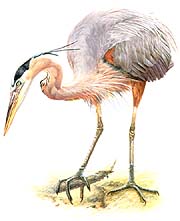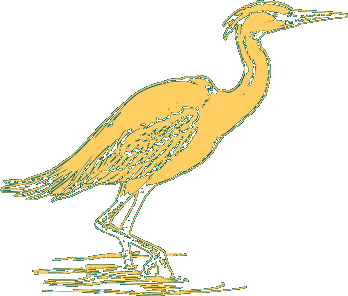
Painting: Hans Peeters
genus: Ardea species: herodias
Great Blue Herons spend a lot of time on the ground, roosting with one leg raised and head nestled into its shoulder. Otherwise, they are alertly watching for prey in shallow water or along a bank. Herons will hunt actively, walking with deliberate steps and neck stretched upwards with no more than a trace of a kink. Herons can swim across deeper water. Their flight is slow and deliberate, with a distinctive wingbeat. In flight, the heron's head is drawn back and the legs trail behind.
Great Blue Herons eat mainly fish but their diet is very varied. Small rodents and frogs are probably the next most important prey. Crabs, prawns, shrimps, beetles, wasps, worms and snails and surprisingly small birds and mammals are sometimes attacked. Herons have been seen eatiing baby ducklings and even goslings. Prey is caught with a sudden thrust of the bill, but is seized in the bill rather than stabbed in the manner of darters.
During courtship the Great Blue Heron will put on quite elaborate displays, either at the nest or in the air, involving movements of the neck and wings and loud snapping of the bill. Herons nest in colonies (sometimes more than a hundred pairs), often with two or more species mixing and feeding together. Sometimes several nests are built in a single tree.
The Great Blue Heron's nest is usually built in a high tree but is sometimes on the ground, on cliff ledges or in reed beds. The nest is a platform of twigs or reeds, collected by the male and placed in position by the female. Used year after year, the nest is repaired and extended each spring unless it is completely destroyed. Three to five eggs are incubated for about 25 days by both parents. Young herons fly when about two months old. Before then, the parents bring food to the nest.
Great Blue Herons have three powder down patches, one on the breast and one behind each thigh. They consist of a group of downy feathers that continually crumble into a fine powder. Herons use this to absorb slime collected on their feathers after feeding on fish, first rubbing it into the plummage with the bill then scratching it out with the comb-like claws on their middle toes.
Recognition: Very large — 50 to 54 inches long. Adult mainly grey; head white with two black corwn stripes, yellow bill. Young birds similar, but crown all black. Great white heron (all white) is found only in Florida and is actually a colour phase of the great blue.
Habitat: Marshes, lakes, rivers and shores.
Nesting: Nest is a platform of sticks in bushes or trees up to 100 feet above ground, or on rocks or cliffs. Lays three to seven pale blue or greenish eggs which are incubated about by both parents for about 28 days. Young downy, leave nest about eight weeks after hatching. Usually nests in colonies.
Food: Fish, frogs snakes and small mammals.
References:
Book of North American Birds. Cassidy, J.; Scheffel, R. L.; Ferguson, G. Eds. Readers Digest Association Inc. 1990.
Funk & Wagnalls Wildlife Encyclopedia 9. Funk & Wagnalls, Inc. New York, NY, 1969/1970.

![[Previous]](../previous_off.gif)
![[Enlarge]](../enlarge_off.gif)
![[Next]](../next_off.gif)